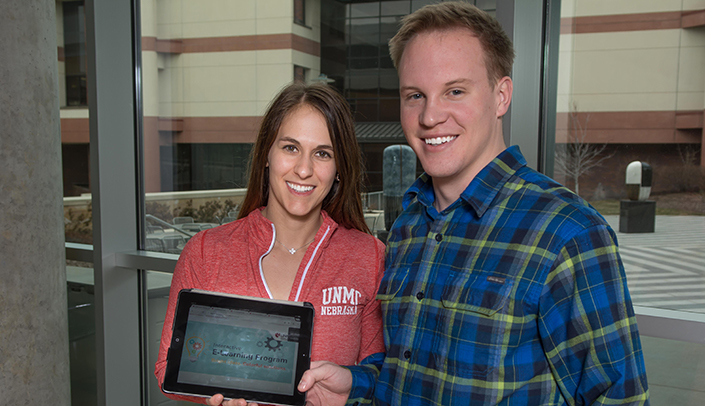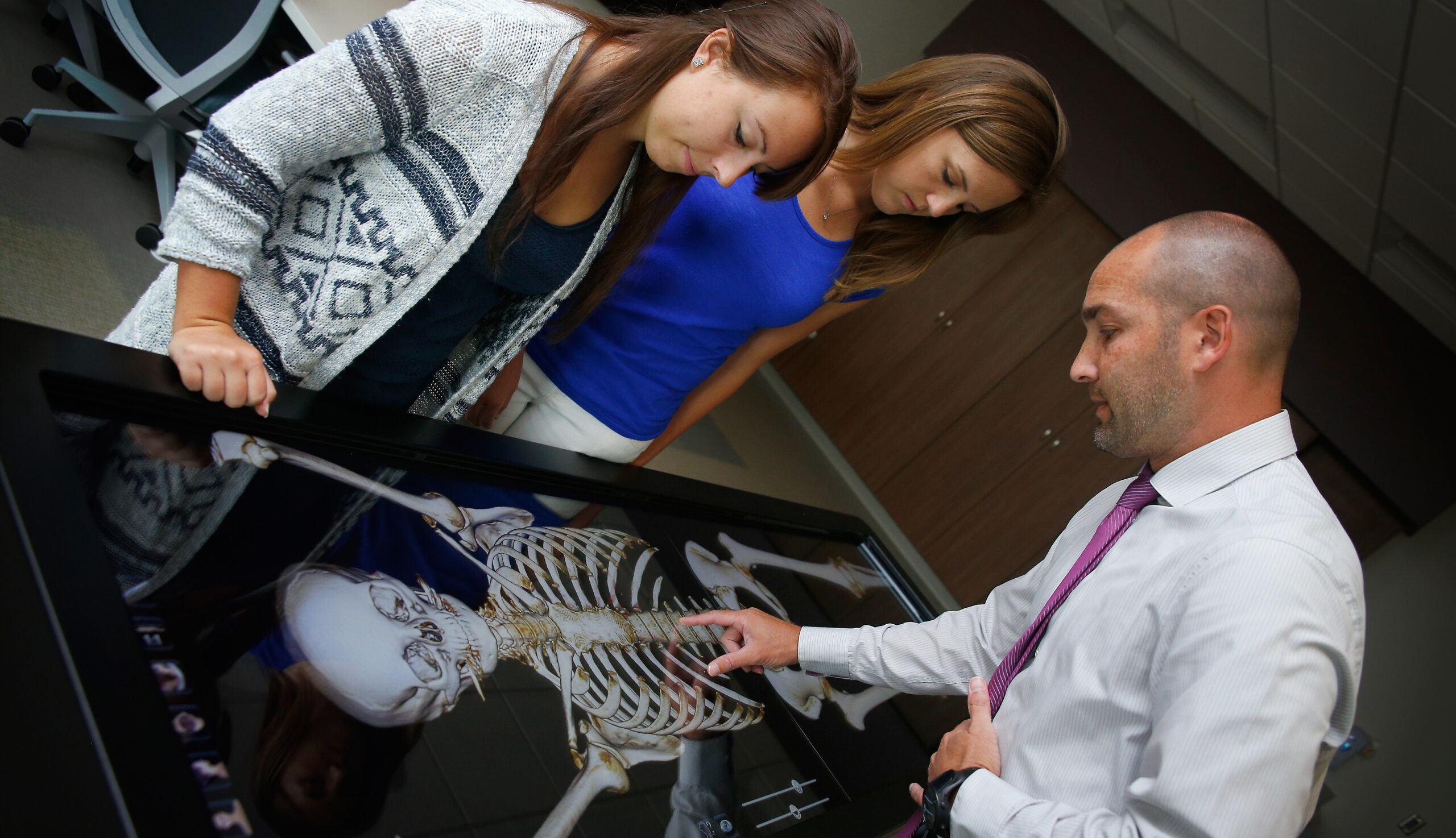A common theme throughout UNMC’s transformative education initiatives is that health professions education must become more experiential, not only to reach today’s learners, but to better build competency at a lower cost.
In this, UNMC teams – not only administration and faculty, but students as well – are leading the way to a new model for health sciences education.
This new model is interprofessional as well as hands-on.
“It only makes sense for us to be working together,” said third-year pharmacy student Beau Ehlers. “That’s the way it’s going to be in the future. We might as well start today.”
To that end, faculty adviser David McMillan, Ph.D., professor, pharmacology and experimental neuroscience, mentored Ehlers in his collaboration with Caitlin Fee, a third-year medical student, to create their own e-module as part of the UNMC E-Learning Program. Their collaboration is a model for the future.
And, it made sense – in their second years, pharmacy and med students study pharmacology together. “We have to learn a lot of drugs in a very short amount of time,” Fee said.
“In our module, we try to integrate the microbiology principles with the antibiotics so students can better understand the structure of the cell wall and how cell wall synthesis inhibitors affect that,” she said. “And we also use little pictures to help students remember in a clever and unique sort of way.”

Medical and pharmacy students, Caitlin Fee and Beau Ehlers, worked together to develop an e-module to help students understand cell wall synthesis inhibitors.
That’s just one of the new ways in which today’s millennial students – UNMC Chancellor Jeffrey P. Gold, M.D., calls them “digital natives” – learn differently than their predecessors.
Added Vice Chancellor for Academic Affairs Dele Davies, M.D., “I believe our future is one where we use a blend of different teaching methods, tools and technology that enable students to learn in the manner and speed that best suits them.”
And so, said Dr. Gold, “Not only have the millennial learners’ needs changed, but our faculty’s needs have changed as well.”
Thus, another innovative educational initiative – a new teaching academy – was born at UNMC. The academy will teach teachers how to reach today’s (and tomorrow’s) students. They will use the latest technology, new learning methods, fewer lectures, more simulation and experiential learning, all while teaching the students to teach themselves, through collaborative peer learning and the like. They’ll focus less on memorization, more on hands-on competency and collaborative problem solving.
It’s a whole new way of thinking. And teaching.
“We envision the Interprofessional Academy of Educators as that center where teachers from every college will come to share their ideas, solve common problems, and mentor the next generation of educators,” said Howard Liu, M.D., director of faculty development.
“We envision the Interprofessional Academy of Educators as that center where teachers from every college will come to share their ideas, solve common problems, and mentor the next generation of educators.”
Howard Liu, M.D.
The academy will receive support from three separate funding streams: the University of Nebraska’s Programs of Excellence, the Grissom Fund and the College of Medicine Alumni Engagement Council. Dave Goldner, M.D., chair of the education committee of the UNMC College of Medicine Alumni Engagement Council, said the alumni will provide support to engage preceptors and alumni across the state with the teaching academy, to improve their teaching skills and better serve students and residents.
And, down the line, to better serve patients in Nebraska and beyond.
Geoffrey Talmon, M.D., associate professor, pathology/microbiology, Linder Residency Director Distinguished Chair and a Golden Apple Award Hall of Famer, has been named the academy’s inaugural director. His teaching philosophy made him a perfect fit for the job.
“What we need to do as physicians, nurses, pharmacists and other health care professionals,” Dr. Talmon said, “is apply the same evidence-based strategies to our education that we do to our clinical practices. We need to step out of our world and not simply do something because it’s the way it’s always been done, or it’s what we went through.
“And so we are becoming more problem-focused,” said Dr. Talmon, “rather than subject-focused. The emphasis becomes less on knowing a particular fact, which anyone can look up in seconds now with today’s technology, but in learning how to reason, how to make the correct decisions.”
The academy’s associate directors, Kim Michael, Anderson Distinguished Professor of Imaging Sciences in the College of Allied Health Professions (CAHP), and Andrew Patterson, M.D., Ph.D., Larson Professor of Anesthesiology, make it a truly interprofessional leadership team.
“The team members have diverse backgrounds and skill sets that will foster innovation and are all strongly committed to the academy mission of fostering a vibrant interprofessional community of educators,” said Greg Karst, Ph.D., executive associate dean for academic affairs in the CAHP.
Dr. Karst served as co-director of the Interprofessional Academy Council Subcommittee, tasked with finding the academy’s leadership team. Dr. Liu also served as co-director.
But UNMC’s instructors also will have at their disposal world-class tools and infrastructure with which to teach – including the approved $102 million Global Center for Advanced Interprofessional Learning at UNMC, which will house the iEXCELSM initiative.
The 134,000-square-foot, multi-level structure is planned for the southeast corner of 42nd and Emile Streets, and will be connected to adjacent facilities – the Michael F. Sorrell Center for Health Science Education to the north and the Lauritzen Outpatient Center to the east – via skywalks.
The legislature in 2015 allocated $25 million toward design and construction of the Global Center, as well as $2 million for operations and maintenance of the new facility. Additional funding support for the Global Center for Advanced Interprofessional Learning and iEXCEL will come from public and private funds. UNMC leaders project construction of the Global Center to Medical and pharmacy students, Caitlin Fee and Beau Ehlers, worked together to develop an e-module to help students understand cell wall synthesis inhibitors. begin in January 2017, with substantial completion by summer 2018. According to an analysis by Tripp Umbach, a leading national consultant, the annual economic impact of iEXCEL will be $39.3 million.
iEXCEL, the campus-wide initiative that includes surgical and advanced simulation clinical settings and virtual immersive reality technology, will help transform how health science education and clinical care is delivered through competency-based learning and assessment.
And students such as Fee and Ehlers aren’t the only ones exploring this technology’s new possibilities – with institution-wide encouragement, often through the teaching academy, faculty are too.
“The opportunities are only limited by your imagination, your willingness to have grit and to try things in a new way,” said Pam Boyers, Ph.D., associate vice chancellor for iEXCEL. “In addition to our academic mission, iEXCEL also has a research and business mission, providing for safe environments for faculty and staff to collaborate with industry and others in the research and innovation realms.”
Already, Michael and Tanya Custer, assistant professor of radiation science technology education, are leading the charge, having received funding from Dr. Davies’ office and the CAHP to develop a series of e-learning modules for UNMC’s Anatomage virtual dissection tables.
UNMC’s new e-Learning Development Laboratory offers a tremendous resource, with its facility, staff and software, to help faculty and students put together such modules.
And a new MultiTaction iWall in the Sorrell Center is an experiential tool that enables new ways of thinking and provides a safe place to innovate in an engaging manner. Its interactive way of presenting content in an innovative and intuitive way can transform collaboration and communication as users flesh out ideas in real time.
Additionally, faculty and students at the colleges of nursing and allied health professions already are taking advantage of the technology and learning environment at the new $19 million Health Science Education Complex, which hosts UNMC’s programs on the University of Nebraska at Kearney campus. The Kearney complex features state-of-the- art technology equal to that of the Omaha campus, which also provides unprecedented distance-learning opportunities between the two sites and across the state.
Dr. Karst, who heads up allied health’s efforts in Kearney, noted that the complex features $2.5 million worth of audio/visual technology.

Physician assistant students Kaylee Samway of McCook, Neb., left, and Emily Buck of Holdrege, Neb., work on the Anatomage table, a life-size 3D interactive touch screen in Kearney with faculty member Ryan Splittgerber, Ph.D.
“People are in awe of everything going on inside this facility. It has been a tremendous transition,” said Mary Ann Mertz, Ed.D., interim assistant dean for the College of Nursing Kearney division.
She continued: “This building is pushing us to expand our teaching styles.”
The nation is noticing UNMC’s leadership in the transformation of health science education.
Competency, interprofessionalism and iEXCEL are key elements in UNMC’s College of Medicine being named one of just 20 medical schools nationwide selected by the American Medical Association (AMA) for its Accelerating Change in Medical Education Consortium. Through the consortium, UNMC takes a leading role in creating “the medical school of the future.”
“It signifies a new day for how physicians will be trained to provide care in the 21st century health delivery system,” Dr. Gold said. “The health system is evolving, and it’s important that we take a leadership role.”
UNMC’s project within the consortium will focus on transitioning interprofessional education into interprofessional practice with the goal of advancing teamwork and communication among health professionals.
This is precisely the kind of thing the aforementioned medical and pharmacy students, Fee and Ehlers, already work on. Together.
But, that’s on the micro level. Big picture: “Joining this initiative provides greater opportunity to collaborate within the UNMC colleges and Nebraska Medicine,” said Kelly Caverzagie, M.D., associate dean for educational strategy in the UNMC College of Medicine and principal investigator for UNMC in the consortium. “The colleges have been working on curriculum changes related to interprofessional practice.”
Meanwhile, a framework developed by Dr. Caverzagie helps faculty “see” competence by defining, and then evaluating students on their demonstration of pre-defined competencies. This framework can help UNMC assess interprofessional practice and interprofessional care.
As Dr. Talmon noted, the same evidence-based strategies being used in research and clinical care are coming to education as well.
As a reflection of UNMC’s efforts in these areas, the Liaison Committee on Medical Education (LCME), which accredits medical schools, honored Dr. Gold with the organization’s Outstanding Service Award for 2015. The honor has been given only three times in the LCME’s history.
It’s a sign that UNMC is headed in the right direction, one in which both faculty and students are learning to be innovators, taking the lead in a new era of health care education and delivery.
Web extras
Learn more about the Interprofessional Academy of Educators.
Watch a video about the Academy.
